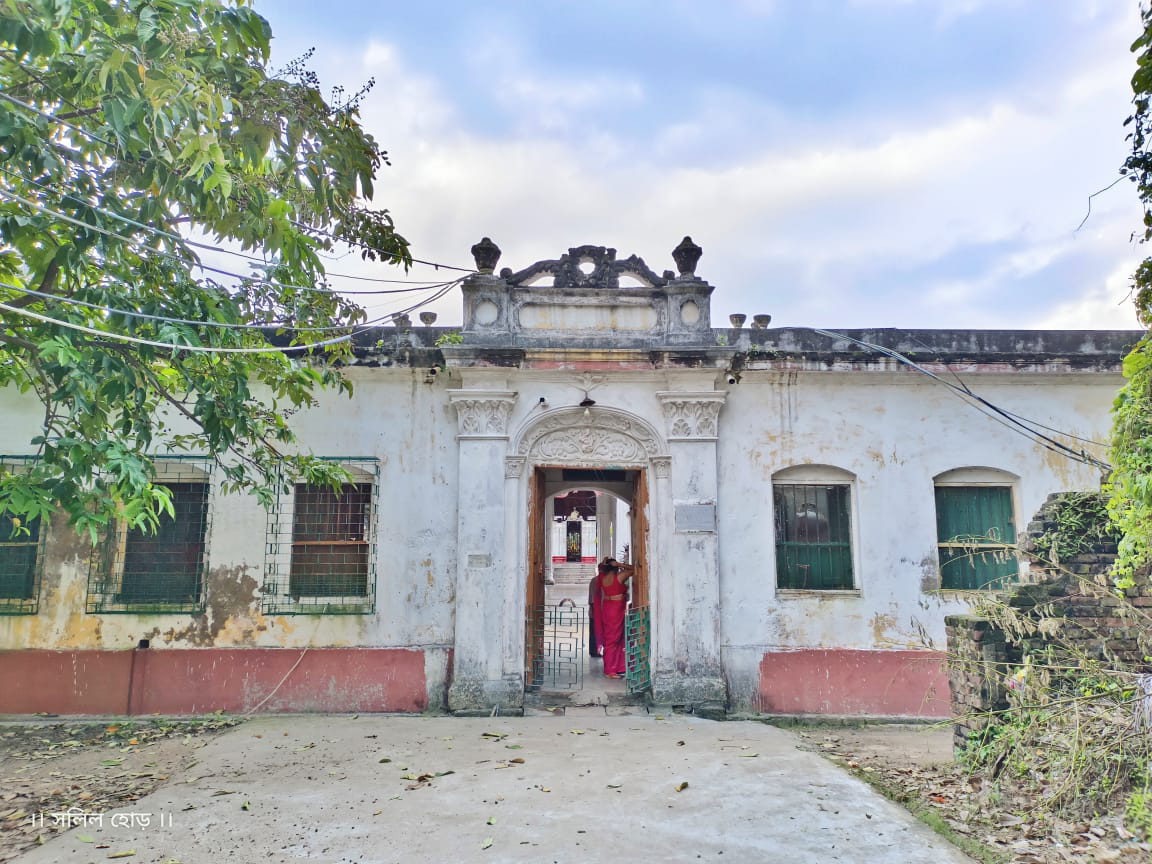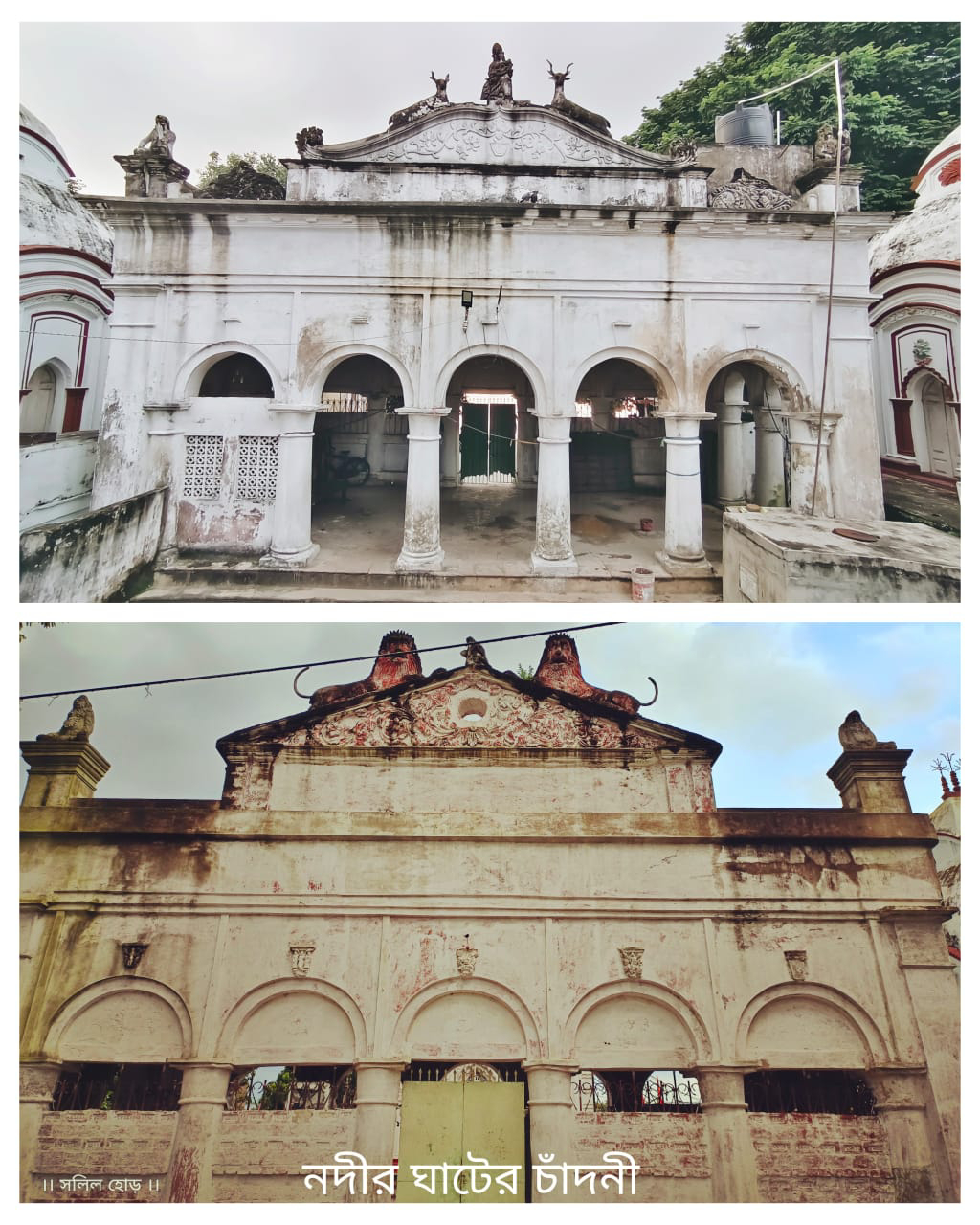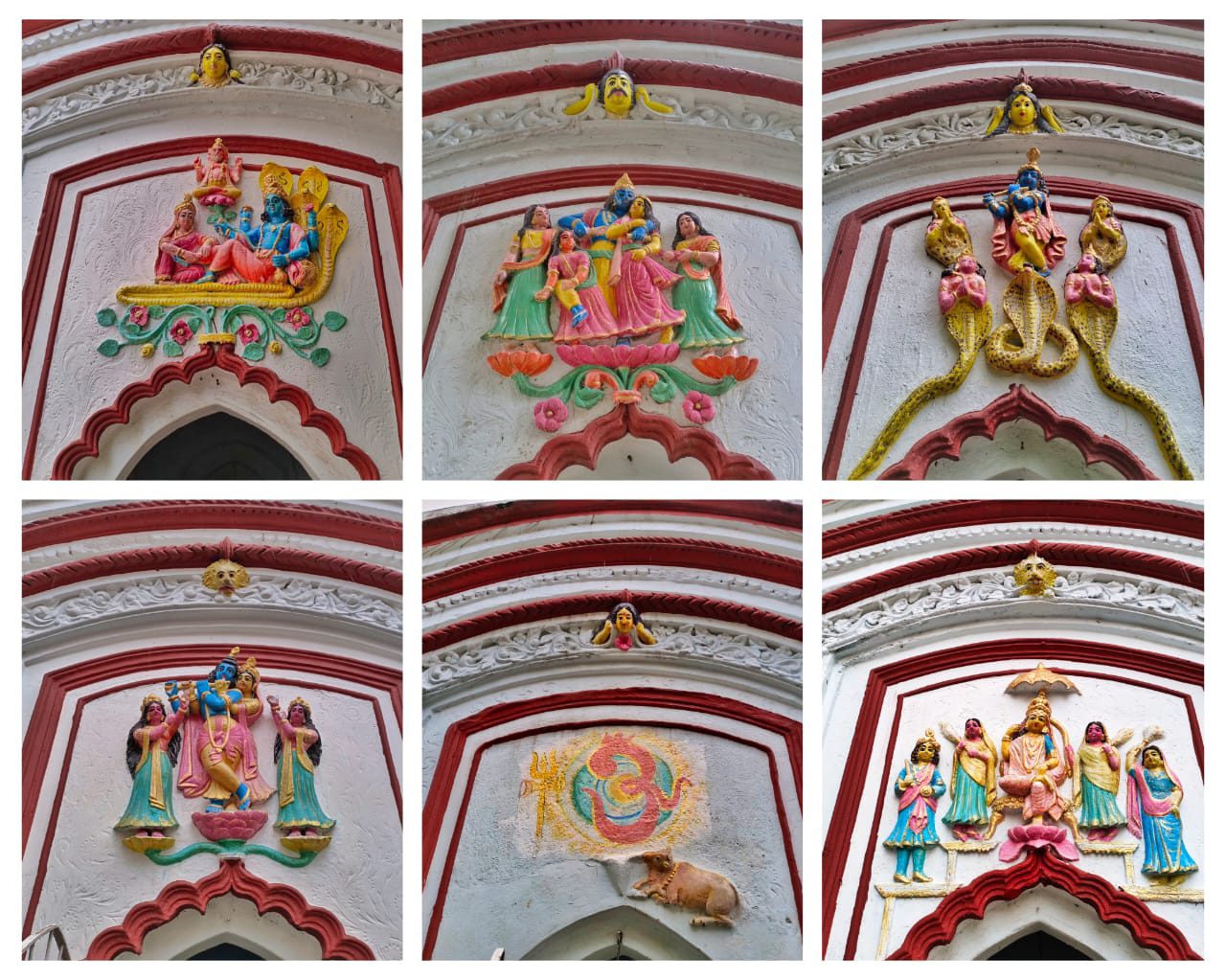রাধা গোবিন্দ কুঞ্জ মন্দির : গিরিবালা দাসীর ঠাকুরবাড়ি, আগরপাড়া (Radha Govinda Kunja Temple : Giribala Dasi Thakurbari, Agarpara)
বি টি রোডের পাশ দিয়ে বয়ে গেছে হুগলি নদী। এর দুই তীরে গড়ে উঠেছে বহু মন্দির। দক্ষিণেশ্বর থেকে ব্যারাকপুর পর্যন্ত ছড়িয়ে আছে সেই মন্দিরগুলো। এর মধ্যে আগরপাড়া-সোদপুর-পানিহাটি অঞ্চলে রয়েছে বেশ কয়েকটি গুরুত্বপূর্ণ মন্দির, যে মধ্যে কিছু কিছু হেরিটেজ তকমা পেলেও, অনেক মন্দির লাইমলাইটে আসে নি। সেগুলোর মধ্যেই একটা নিয়ে বলবো আজকে।
আগরপাড়া অঞ্চলে, নদীর তীরে রয়েছে একটি সুপ্রাচীন ঠাকুরবাড়ি... যার সাথে জড়িয়ে আছে গিরিবালা দাসীর নাম। রাণী রাসমণির জ্যেষ্ঠা কন্যা পদ্মামণির নাত-বৌ ছিলেন গিরিবালা দাসী। তিনি ছিলেন রূপে লক্ষ্মী, গুণে অসামান্যা। অকালে তাঁর তিন পুত্র এবং স্বামী গোপালকৃষ্ণ গত হবার পরে, অন্তরের শোক-তাপ নিয়েই তিনি সৎকার্য্যে মনোনিবেশ করেন। তাঁর প্রাতস্মরণীয়া দিদি-শাশুড়ী রাণী রাসমণির পদাঙ্ক অনুসরণ করে, ১৩১৮ বঙ্গাব্দে ১৮ই জ্যৈষ্ঠ (১লা জুন ১৯১১ ইং) বৃহস্পতিবার তিনি এই ঠাকুরবাড়ি পত্তন করেন। এর নাম তিনি রাখেন 'রাধা গোবিন্দ কুঞ্জ মন্দির'।
এই ঠাকুরবাড়ি তৈরী করতে খরচ হয়েছিল প্রায় তিন লক্ষ টাকা। স্থপতি ছিলেন অবসরপ্রাপ্ত ডিস্ট্রিক্ট ইঞ্জিনিয়ার গগনচন্দ্র বিশ্বাস এবং এস এম ঘোষ অ্যান্ড কোম্পানি। দক্ষিণেশ্বর মন্দির প্রতিষ্ঠার ৫৬ বছর বাদে এটি প্রতিষ্ঠিত হয়।
এবার আসা যাক মন্দিরের বর্ণনায়। মূল ফটক দিয়ে প্রবেশ করলেই সামনে পড়বে একটা বৃহৎ কারুকার্যময় নাটমন্দির, যেখানে লতা, গুল্ম, পাতা দিয়ে খুব সূক্ষ্ম বিভিন্ন শিল্পকলার কাজ দেখা যায়। এছাড়াও রয়েছে নহবতখানা। দুটি নহবতখানা ছিল, একটি রয়েছে। আরেকটি ভেঙে যাওয়ায় নতুন করে তৈরি হচ্ছে।
মন্দির প্রাঙ্গণটি উঁচু পাঁচিল দিয়ে ঘেরা। মূল মন্দিরটিতে প্রধান পূজিত হচ্ছেন রাধাগোবিন্দ, কষ্টিপাথরের কৃষ্ণ ও অষ্টধাতুর রাধা। এদের সাথেই রয়েছে গণেশ, নারায়ণ শিলা, অন্যান্য দেবদেবীর মূর্তি এবং গিরিবালা দেবীর জপ রতা পিতলের মূর্তি।
পঞ্চরত্ন মন্দিরটি দক্ষিণমুখী, এবং ৭ ফুট উঁচু বেদীর উপর অবস্থিত। মন্দিরের প্রবেশপথের সিঁড়ির দুপাশে রয়েছে, বাতিদান হাতে পাথরের দুই নারীমূর্তি। রয়েছে পঙ্খের অপূর্ব কারুকাজ, যেখানে চারদিকে বাঁশির ছাপ দেখা যায়। একেদিকে হাঙরের মাথা আর প্রত্যেক দিকে দুটো করে বাঁশির আদল।
দক্ষিণেশ্বর মন্দির কমপ্লেক্সের মতো এই মন্দিরেও একটি সুন্দর গঙ্গার ঘাট রয়েছে, যেখানে যাওয়ার জন্যে রয়েছে চাঁদনি দালান (মন্দির থেকে গঙ্গার ঘাটে যাওয়ার রাস্তা)।
নাটমন্দিরের দুই পাশে প্রায় ৬ ফিট উঁচু বেদীতে, তিনটি তিনটি করে মোট ছয়টি শিবমন্দির রয়েছে। দক্ষিণদিকে প্রথম মন্দিরটি রামেশ্বর, দ্বিতীয়টি রাজেশ্বর এবং তৃতীয়টি গোপেশ্বর। উত্তরদিকে প্রথম মন্দিরটি তারকেশ্বর, দ্বিতীয়টি ভুবনেশ্বর ও তৃতীয়টি গিরিশ্বর শিব। সবকটি শিব মন্দিরেই সামনে ও পিছনে রয়েছে অপূর্ব পঙ্খের ভাস্কর্য।
রামেশ্বর মন্দিরের পূর্বদিকের প্রবেশদ্বারের উপর রয়েছে 'যুগলমিলন মূর্তি'। পশ্চিমদিকের দরজার উপর রয়েছে 'কৃষ্ণ বলরাম মূর্তি'। রাজেশ্বর শিব মন্দিরটির পশ্চিম দরজার উপরে রয়েছে 'রাম রাজার মূর্তি', মূর্তিতে রামসীতার আসনের নীচে দুইটি বাঁদর বসে আছে। গোপেশ্বর শিবের মন্দিরের পূর্বদিকের দরজায় রয়েছে 'রাই রাজার মূর্তি'। মূর্তিতে পদ্মাসনে বসে থাকা রাধার দুদিকে দুইজন করে সখীর মূর্তি রয়েছে, পশ্চিমের দরজার উপরে রয়েছে 'শিবের বিবাহ' দৃশ্য। সেখানে বলদের পিঠে হরপার্বতী ছাড়াও একজন শিঙ্গাবাদক ও একজন শঙ্খবাদক রয়েছেন। তাঁরকেশ্বর শিব মন্দিরের পিছনে রয়েছে 'মার্কণ্ডেয় উদ্ধার মূর্তি'। ভুবনেশ্বর শিব মন্দিরের পেছনে রয়েছে 'অন্নপূর্ণা'। গিরিশ্বর শিবমন্দিরের উত্তরপাশে রয়েছে 'প্রতীক্ষামাণা', আর পিছনে 'হরহরি মিলন' এর মতো অনেক পৌরাণিক অনুষ্ঠানের নকশা। একটা বিষয় যেটা আমার উল্লেখযোগ্য লাগলো, সেটা হলো শিব মন্দিরে কৃষ্ণের লীলা বর্ণিত হয়েছে, যেটা সাধারণত দেখা যায় না।
মূল মন্দিরের পূর্বদিকের ঘরগুলোতে আছে অফিস, রান্না ও ভাঁড়ার ঘর, এবং সেবকদের থাকার জায়গা। গিরিবালা দেবীর উত্তরসূরিদের ইচ্ছায় ১৯৮৫ সালের ২৩ জানুয়ারি, মহামণ্ডলেশ্বর শ্রী শ্রী শিবানন্দ গিরি মহারাজের তত্ত্বাবধানে হরিদ্বারের ভোলানন্দ সন্ন্যাস আশ্রম এই মন্দিরের দায়িত্ব গ্রহণ করে। এখন গিরিবালা ঠাকুরবাড়ি ভোলাগিরি স্নেহনীড় নামেও পরিচিত। শিবানন্দ নিজ উদ্যোগে এই মন্দিরের প্রথম সংস্কার করেন। প্রসঙ্গত উল্লেখ্য, মন্দিরের রাধারানির মূর্তিটি শিবানন্দ প্রতিষ্ঠিত। গিরিবালা প্রতিষ্ঠিত মূর্তিটি চুরি গিয়েছিল। পরে একটি শ্বেত পাথরের মূর্তি পূজিত হত, যা অসাবধানতাবশত ভেঙে যায়। পরে শিবানন্দ গিরি বৃন্দাবন থেকে অষ্টধাতুর রাধারানির মূর্তি গড়িয়ে নিয়ে আসেন।
মন্দির চত্বরে ঢোকার আগে, একটা ভগ্নপ্রায় দালাম বাড়ি চোখে পড়ে। কিন্তু খোঁজ খবর করে এই বাড়ির সম্পর্কে খুব একটা বিস্তৃত আমি জানতে পারি নি। মন্দির কর্তৃপক্ষ এটাই বললেন, যে এটিও গিরিবালা দাসীর পরিবারের সম্পত্তি। বাড়িটির চারদিকে আছে মাঠ, সেখানে স্থানীয় ছেলেরা ফুটবল খেলে।
২০২১ সালের ৮ ডিসেম্বর রাধাগোবিন্দ কুঞ্জ অর্থাৎ গিরিবালা ঠাকুরবাড়িকে পশ্চিমবঙ্গ হেরিটেজ কমিশন হেরিটেজ সাইট হিসেবে ঘোষণা করেছে। এখানে দিনে নিত্যভোগ হয়, অন্নভোগ। দিনে চার- পাঁচবার পুজো হয়। সারা বছর উৎসব হয়, মন্দিরে প্রতিষ্ঠা উৎসব, রথ, রাধাষ্টমী, জন্মাষ্টমী, দোলযাত্রা, স্নানযাত্রা, ঝুলন, রাসযাত্রা, নীলষষ্ঠী, শিবরাত্রি ইত্যাদি পালিত হয়। আশা করা যায়, মন্দিরটি আগরপাড়া অঞ্চলে চিরকাল তার স্বমহিমায় বিরাজমান থাকবে।
তথ্যসূত্র ও সহায়তা: শ্রী শেখর শেঠ এবং মন্দির কর্তৃপক্ষ।
************************************
Radha Govinda Kunja Temple: Giribala Dasi's Thakurbari, Agarpara
The Hooghly River flows alongside BT Road, its banks dotted with numerous temples stretching from Dakshineswar to Barrackpore. The Agarpara-Sodepur-Panihati region is home to several significant temples; while some have received heritage recognition, many others remain less widely known. Today, I will be discussing one such temple.
In the Agarpara area, nestled on the riverbank, stands an ancient Thakurbari (a traditional family temple complex) associated with the name Giribala Dasi. She was the granddaughter-in-law of Padmamani, the eldest daughter of the renowned Rani Rashmoni. Giribala Dasi was celebrated for her beauty and exceptional qualities. Following the premature deaths of her three sons and husband, Gopalakrishna, she channelled her profound grief into philanthropic and religious activities. Emulating the path of her esteemed elder sister-in-law, Rani Rashmoni, she founded this Thakurbari on Thursday, June 1st, 1911 AD (18th Jaishtha, 1318 Bengali Calendar). She named it 'Radha Govinda Kunja Temple'.
The construction of this Thakurbari cost approximately three lakh rupees. The architects were Gaganchandra Biswas, a retired District Engineer, and S.M. Ghosh & Company. It was established 56 years after the founding of the Dakshineswar Kali Temple.
Now, let's describe the temple itself. Upon entering through the main gate, you are immediately greeted by a large, intricately carved Natmandir (Prayer Hall). This hall features exquisite artistry depicting vines, foliage, and various delicate motifs. The complex also originally had two Nahabatkhanas (towers for playing ceremonial music); one still stands, while the other collapsed and is currently being reconstructed.
The temple complex is enclosed by a high wall. The main temple houses the principal deities, Radha-Govinda. The idol of Krishna is crafted from touchstone (Kosti Pathor), while Radha is made of Ashtadhatu (an alloy of eight metals). Also present are idols of Ganesh, a Narayan Shila (sacred stone representing Vishnu), other deities, and a brass idol of Giribala Devi depicted in meditation.
The main temple is a Pancharatna (five-pinnacled) structure, facing south and situated on a 7-foot high platform. The steps leading to the entrance are flanked by stone figures of women holding lamps. The temple features exquisite Panka (lime-plaster relief) work, including remarkable carvings. Notably, these include motifs resembling flutes or pipes, and on one side, a distinctive element described as a 'shark's head'.
Similar to the Dakshineswar temple complex, this temple boasts a beautiful ghat leading down to the Ganges River. A 'Chandni Dalan' (a covered walkway) provides a sheltered passage from the temple to the ghat.
Flanking the Natmandir, on platforms approximately 6 feet high, are six Shiva temples, three on the south side and three on the north. The southern temples are dedicated to Rameshwar, Rajeshwar, and Gopeshwar, while the northern ones house Tarkeshwar, Bhubaneshwar, and Girishwar. All six Shiva temples are adorned with superb Panka sculptures on their front and rear facades.
The Panka sculptures on these temples depict various mythological scenes. On the Rameshwar temple, the eastern entrance features the 'Jugalmilana Murti' (Confluence of the Couple), while the western door bears the 'Krishna Balaram Murti'. The Rajeshwar Shiva temple's western door displays the 'Ram Raja Murti,' showing Rama and Sita seated with two monkeys below their seat. The Gopeshwar Shiva temple's eastern door has the 'Rai Raja Murti,' where Radha is shown in a lotus pose flanked by two sakhis on each side; the western door above depicts the 'Marriage of Shiva,' including Shiva and Parvati on a bull, along with a horn player and a conch player. The rear of the Tarkeshwar Shiva temple features the 'Markandeya Rescued' sculpture. 'Annapurna' is depicted on the back of the Bhubaneshwar Shiva temple. The Girishwar Shiva temple's north side shows a 'Pratikshyamana' (Waiting Figure), and the back includes designs of 'Harahari Milan' (Union of Shiva and Vishnu) and other mythological events. A particularly striking observation is the depiction of Krishna's pastimes (leela) within the Shiva temples, which is quite unusual.
Rooms on the east side of the main temple house the office, kitchen, store, and accommodation for temple staff. Following the wishes of Giribala Devi's successors, the Bholananda Sanyas Ashram in Haridwar took responsibility for the temple's management under the supervision of Mahamandalesshwar Shri Shri Shivananda Giri Maharaj, effective January 23, 1985. The Thakurbari is now also known as Bholagiri Sneheneer. Shivananda Giri initiated the temple's first significant renovation. It's worth noting that the current Ashtadhatu idol of Radharani was established by Shivananda; the original idol established by Giribala was stolen, and a subsequent marble idol was accidentally broken before Shivananda commissioned and brought the Ashtadhatu idol from Vrindavan.
Before entering the temple complex, one notices a dilapidated Dalan house. Despite inquiries, extensive information about this particular structure was not available. Temple authorities confirmed it was also part of Giribala Dasi's family property. The house is surrounded by a field where local boys play football.
On December 8, 2021, the Radha Govinda Kunja, or Giribala Thakurbari, was officially declared a Heritage Site by the West Bengal Heritage Commission. The temple observes daily rituals, including the 'nityabhog' (offering of cooked food), with pujas performed four to five times a day. A variety of festivals are celebrated throughout the year, such as the Temple's Foundation Day, Ratha Yatra, Radhashtami, Janmashtami, Dol Yatra, Snan Yatra, Jhulan, Ras Yatra, Nilshashti, and Shivratri. It is hoped that this temple will forever remain a prominent landmark in the Agarpara area.
Source and Assistance:
Shri Shekhar Seth and Temple Authorities.




















Comments
Post a Comment